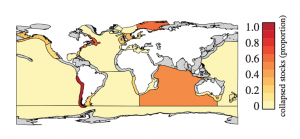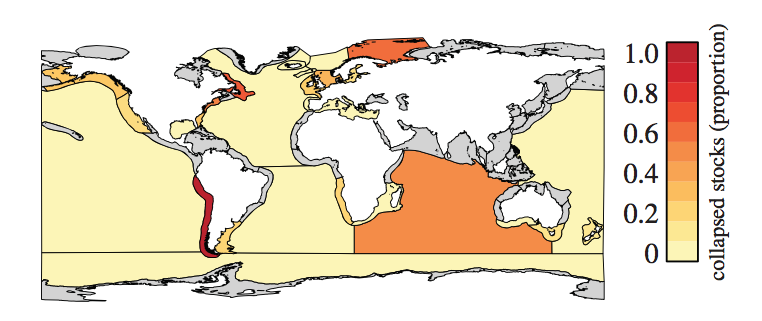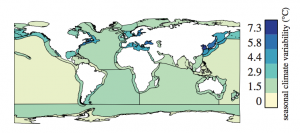Fishery Collapses Explained by Overfishing, Life-History Traits, and Climate Variability
By Christopher Brown, RJD Intern
Species around the world have experienced significant declines below fixed thresholds that indicate the risk of extinction. Evidence has suggested that the risk of extinction runs high in terrestrial species that maintain large body sizes, feed high in the food chain, and demonstrate slow population growth rates. However, within marine ecosystems, species that exhibit fast population growth rates have been found to be just as likely to face the risk of extinction as species with slower population growth rates. Population growth rates can be understood as one of several factors that determine the risk of extinction. Additional factors that may influence the risk of extinction include climate variability and harvest dynamics. Overfishing, especially in waters unregulated by governing bodies, may play a strong role in population collapse. Recent studies have suggested that fast growing marine species subject to climate variability are more sensitive to overfishing than slow growing marine species.

Figure 1: Proportion of fish stocks that have ever collapsed (Gray regions represent large marine ecosystems without fish stock status information) (Pinksy and Byler, 2015).
Pinsky and Byler used boosted regression trees to analyze the effects harvesting, species traits, and climate variability had on one hundred and fifty-four fish populations located around the world. In regards to fish and fisheries data, population collapses were analyzed using the RAM Legacy Stock Assessment Database version 1.0. This large database withholds a time-series of both population biomass and fishing pressure dating from 1950 to 2008. A fish stock was defined as collapsed if the minimum annual biomass dropped below 20% of the biomass necessary to support a maximum sustainable yield (Pinsky and Byler, 2015). The climate variability of seventy large marine ecosystems (LME) was calculated using sea surface temperatures (SST) from an 1870-2014 HadISST dataset. The SSTs were averaged monthly within each LME and the time-series were de-trended by subtracting a linear regression from each set of values. Short-term climate variability was measured to analyze the seasonal cycles, in addition to long-term climate variability. The four main questions that were addressed included (Pinsky and Byler, 2015):
- Do the interactions of fishing with rapid growth rates contribute to population collapses?
- Are fishery collapses more likely in regions with more variable climates?
- Do the interactions of climate and fishing contribute to collapses?
- What are the relative influences of fishing, life history and climate on population collapses?
Pinsky and Byler found that LMEs that had the greatest seasonal climatic variability were either enclosed, coastal areas, or located at intermediate latitudes. The most depleted fish populations in these LMEs had the greatest overfishing durations, maintained faster growth rates, and experienced a significant amount of seasonal climatic variability. Fish populations that were subject to overfishing in LMEs with great climatic variability were determined to be about twice as likely to collapse than fish populations overfished in LMEs with less climatic variability. Even though overfishing was a dominant factor in the models used to analyze fish population collapse, it was determined that life-history characteristics and climate variability predispose fish populations to collapse and depletion (Pinsky and Byler, 2015). Fast growing species have short generation times, and slow growing species have longer generation times. Fish species with short life histories are more prone to collapse, especially if there is a long delay in reducing harvest rates after population growth declines. Fish species with long life histories are able to tolerate longer delays. Because fish species with short life histories are more difficult to incorporate into sustainable fishing practices, dynamic management is needed to rapidly reduce harvest rates when it appears that a fast-growing species is approaching a collapse. Population biomasses and fishing pressures must be monitored closely enough to detect the possibility of the collapse and depletion of global fish populations in order to keep fast growing species above the fixed thresholds that indicate the risk of extinction.
References:
Pinsky, Malin L., and David Byler. “Fishing, fast growth and climate variability increase the risk of collapse.” Proc. R. Soc. B. Vol. 282. No. 1813. The Royal Society, 2015.





Leave a Reply
Want to join the discussion?Feel free to contribute!